Yes. It comes down to the type of spider and its hunting method.
Cobwebs
The irregular, tangled webs that we commonly found spread across plants or hidden in corners are classified as cobwebs.The meaning of cobweb is attributed to an old English reference, which is coppe. The family of spiders that produce the webbing are called the ‘Theridiidae (tangled web spiders, cobweb spiders or comb-footed spiders) and ‘Linyphiidae’ (Sheet weavers or money spiders).
There may or may not be a spider in the web to claim ownership when disturbed. This usually depends on the availability of prey. Much of the time webbing seen most prominently is travel webbing used to launch the spider around the area.

Spider webs
In comparison, the elegant and sphere-like webs that are well associated with spider cartoons are generally known as spider webs. Orb-web producing spiders come from the ‘Araneidae’, ‘Nephilidae’, and ‘Tetragnathidae’ family. Just like the cobweb, the webbing is spun using a proteinaceous fluid emitted by glands called spinnerets.
There are seven types of glands making different types of spider silk for special purposes. Depending on the species a spider can have between one, three and four types. The two most important types produced are viscid silk (sticky, wet and elastic) and dragline silk (tough, dry and structurally secure).

Cobwebs are well associated with dust and looking like they have aged for some time. This is due to the type of spider. Some prefers to leave their cobweb when they believe their current food source is inadequate. This can result in one cobweb being reoccupied by different spiders over time and very little maintenance work as its 3d structure doesn’t solely rely on individual anchor points.

Spider webs can however always look freshly created. This is due to the nature of certain orb spinning spiders which find that a build-up of dust and pollen in their webs renders their sticky 2D webbing ineffective. To counter this they rebuild the webbing each day and eat the old to save on essential proteins contained in the silk.

Old unused cobwebs are best cleaned up with the Cobweb Winder and easily disposed of with a tissue. We recommend using the extender wand for hard to reach places and the regular wand for small tough spots.
